Introduction
Current classifications of the Ophiuroidea recognize two orders, the Euryalida (basket or snake stars) with 5 families, and the Ophiurida (brittle-stars) with 15 families (O´Hara, Hugall, Thuy, Stöhr and Martynov, 2018). Even though the order Euryalida is widely distributed the specimens are not easy to capture since many live in the deep sea and display cryptic behaviors (Hyman, 1955). Most of the species are epizoic and are found among gorgonians, antipatharians, and sponges. They are occasionally associated with hard substrates (Gondim, Dias & Manso, 2012). The members of this order possess specialized morphological attributes of the class Ophiuroidea, including the presence of vertebrae with hourglass-shaped joints (of the streptospondylous type) that allow them to move their arms vertically (Hendler and Miller, 1984).
The Gorgonocephalidae is conformed by 34 genera and is the largest of the three families integrating the order Euryalida (Stöhr, 2015). The species in this family have five intricately branched arms, with rings that have few hook-shaped spines, giving them a banded appearance (Piepenburg, 2000). The disc and the arms in this genus are covered by small granules, except on the interradios (Baker, 1980). There are studies addressing specimens of this family, like O’Hara, Hugall, Thuy, Stöhr & Martynov (2018) who reported a new classification with the morphological diagnosis of the Ophiuroidea taxa. However, the studies referring to species of the family Gorgonocephalidae inhabiting Mexican waters are scarce. An example is the work published by Solís-Marín and collaborators (2014) in which they only present a list of echinoderm species found in Mexican waters with no further analysis or description.
This study will bring together important and specific information of some gorgonocephalid species, the species under consideration are distributed along the Pacific and Atlantic coasts of Mexico, which are home to important reef systems. The taxonomic information on this family has been scarce in comparison with other ophiuroid groups.
Materials and methods
Using the specialized library incorporated in the Laboratory of Echinoderm Systematics and Ecology (LESE, UNAM), some literature specialized in the family Gorgonocephalidae was gathered. Specimens described herein have been cataloged and deposited at the Echinoderm National Collection “Dra. Ma. Elena Caso M.”. Materials were collected in the Pacific and Atlantic Oceans between 1964 and 2007 through multiple expeditions (Table 1). These specimens were preserved dry and in 70 % alcohol. The materials were examined using an OLYMPUS SZX7 stereoscopic microscope and pictures were taken using a Leica stereoscopic microscope at the Biology Institute (BI), UNAM. Some specimens were dissected to analyze and photograph their internal structures, using Scanning Electron Microscopy (SEM) JEOL JSM-6360 LV at ICML, UNAM. The fragments were immersed in commercial house bleach, and then a 5% NaCIO solution to remove muscle tissue. Finally, the mounting was performed in an aluminum sample holder and carbon labels for SEM. Finally, the photographs of the taxonomically important structures used for species identification were edited using Adobe Photoshop CC and were edited to add scales and group all the photographs.
Table 1 Species of the family Gorgonocephalidae reviewed at the Colección Nacional de Equinodermos, Instituto de Ciencias del Mar y Limnología, UNAM
| No. of specimens | Locality | Depth | Preservation condition |
| Asteroporpa (Asteroporpa) annulata (Örstedt & Lütken 1856, in Lütken, 1856) | |||
| 23 | North of Olbox, Quintana Roo. | 69.2 - 730 m | Alcohol |
| 1 | North of Cabo Catoche, Quintana Roo. | 57.5 m | Dry |
| Astracme mucronata (Lyman, 1869) | |||
| 5 | North Atlantic Ocean, Bahamas, Yucatan Mexico. | 305 - 400 m | Alcohol |
| 3 | North of Progreso, Yucatan, Mexico. | 336 m | Dry |
| Astrocaneum herrerai (Clark, 1919) | |||
| 2 | Franco de Contoy, Quintana Roo. | 38 m | Dry |
| Astrocaneum spinosum (Lyman, 1875) | |||
| 1 | Bajo Marisal, Gulf of California. | 40 m | Alcohol |
| 1 | Las Ánimas Island, Gulf of California. | 60 m | Dry |
| Astrocyclus caecilia (Lütken, 1856) | |||
| 2 | Gulf of Mexico. | 87 - 116 m | Alcohol |
| Astrodictyum cf. panamense (Verrill, 1867) | |||
| 5 | The Gulf of California. | 30 - 60 m | Alcohol |
| 12 | Baja California and Oaxaca. | 30 - 40 m | Dry |
| Astrogomphus vallatus (Lyman, 1869) | |||
| 1 | Off Río Lagartos, Campeche’s Bank. | 215 m | Alcohol |
| Astrophyton muricatum (Lamarck, 1816) | |||
| 16 | Contoy Island, Quintana Roo. | 33 m | Alcohol |
| 20 | Contoy Island, Quintana Roo. | 15 - 57 m | Dry |
| Gorgonocephalus chilensis (Philippi, 1858) | |||
| 1 | Puerto Santa Cruz, Bahía Grande, South Atlantic Ocean. | 50 m | Alcohol |
The taxonomic terms used to describe the euryalid brittle stars in this work follow Stöhr, O’Hara, and Thuy (2012) and Okanishi (2016). The taxonomic arrangement was made according to O’Hara et al. (2018).
Abbreviations used in this work: Colección Nacional de Equinodermos, CNE. Universidad Nacional Autónoma de México, UNAM.
Results
A total of 193 specimens were examined, belonging to eight genera and nine species, with a bathymetric distribution from 73 to 201 m. The genus with the highest species richness in the CNE, UNAM was Astrocaneum (two species) and the ones with less specific richness were Asteroporpa, Astrodictyum, Astracme, Astrocyclus, Astrogomphus, Astrophyton, and Gorgonocephalus (with one species each).
Taxonomic synopsis
Class Ophiuroidea
Order Euryalida Lamarck, 1816
Family Gorgonocephalidae Ljungman, 1867
Genus Asteroporpa Örstedt & Lütken, 1856 in Lütken, 1856
Asteroporpa (Asteroporpa) annulata (Örstedt & Lütken, 1856 in Lütken, 1856)
Genus AstracmeDöderlein, 1927
Astracme mucronata (Lyman, 1869)
Genus AstrocaneumDöderlein, 1911
Astrocaneum herrerai (Clark, 1919)
Astrocaneum spinosum (Lyman, 1875)
Genus AstrocyclusDöderlein, 1911
Astrocyclus caecilia (Lütken, 1856)
Genus AstrodictyumDöderlein, 1927
Astrodictyum panamense (Verrill, 1867)
Genus AstrogomphusLyman, 1869
Astrogomphus vallatus (Lyman, 1869)
Genus AstrophytonFleming, 1828
Astrophyton muricatum (Lamarck, 1816)
Genus GorgonocephalusLeach, 1815
Gorgonocephalus chilensis (Philippi, 1858)
Order Euryalida Lamarck, 1816
Diagnosis (O’Hara et al., 2018): arm spine articulations with muscle and nerve openings well separated. Arm spines ventral only. Lateral arm plates devoid of ornamentation. Vertebrae with hourglass-shaped articulations.
Family Gorgonocephalidae Ljungman, 1867
Diagnosis (O’Hara et al., 2018): dorsal part of the disc and arms with scales and plates, which bear thorny granules or spines. In the arms, they present Girdles of small hyaline hooks. Arms branched or simple. All vertebrae without an oral bridge. Multiple teeth in irregular columns, dental plate whole. Arm spine articulation with slit-shaped muscle opening proximally bordered by a vertical ridge, small nerve opening at a distance.
Genus Asteroporpa Örsted & Lütken 1856, in Lütken, 1856
Diagnosis (Örstedt & Lütken, 1856 in Lütken, 1856): disc with 10 short radial shields and five arms, extremely long and tightly articulated arms that are very narrow at their ventral side. Both radial shields are elevated from the arm region and covered by skin with warts and articulated hooks. Along the borders of the mouth, they exhibit sharp cone-shaped papillae. They have short hooklets underneath the arm rings.
Asteroporpa (Asteroporpa) annulata
(Örstedt and Lütken, 1856 in Lütken, 1856)
Fig. 1A, Fig. 1B, Fig. 1C, Fig. 1D, Fig. 6A, Fig. 6B.
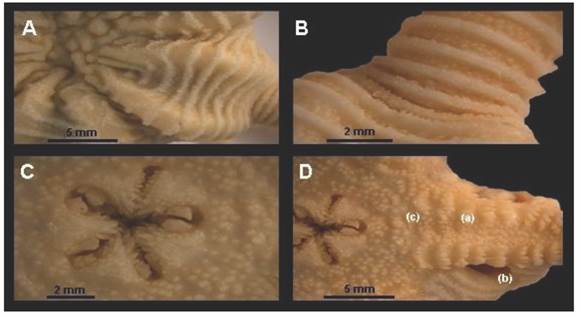
Fig. 1 Asteroporpa (Asteroporpa) annulata (ICML-UNAM 3.120.1). A. Ventral aspect of the central region of the disc showing the rings over the radial shields. B. Dorsal aspect of the basal portion of the arm showing the ring. C. Mouth. D. Ventral aspect of the basal portion of the arm. (a). Arms spines (b). Bursal slit (c). Granules.
Asteroporpa (Asteroporpa) annulata Örstedt & Lütken, 1856 in Lütken, 1856: 17, Fig. 4a-d, Fig. 5a-b; Lyman, 1882: 125; Verrill, 1899 (b): 320; Döderlein, 1911: 24, Fig. 2a-f; Döderlein 1927: 89; Gondim et al., 2012: 142-145, Fig. 1.
Diagnosis (Gondim et al., 2012): aboral part of the disk covered by a thick skin, the radial shields and their surrounding are tumid, bar-like, extending more than half of the disk diameter, and covered by five rows of rings with sharp granules. The jaws and oral parts are covered by a thick skin and show small, flattened dermal ossicles. There are five simple arms; the dorsal and lateral surfaces of the arms are annulated, with inflated, white, and transverse rows of hooklet-bearing plates.
Scanning Electron Microscopy: Asteroporpa (Asteroporpa) annulata can be distinguished by its type of spines, which no other organism possesses. These spines have a rectangular base with five to seven spikes, the hooklets have an open and marked base, with clear edges; there are six very noticeable perforations found along the hooklet, at the secondary tooth base there is a groove, and the main hooklet is long (Fig. 6A, Fig. 6B).
Genus AstracmeDöderlein, 1927
Diagnosis (Döderlein, 1927): disc and arms with thick spines, one madreporite; the first section of the arms exhibits many ramifications. They exhibit small tentacle pores before the first bifurcation; from one to three arm spines (small-sized), beginning before or immediately after the first arm bifurcation; all the final bifurcation are thin, with hooks and well-developed hook rows.
Astracme mucronata (Lyman, 1869)
Fig. 2A, Fig. 2B, Fig. 2C, Fig. 2D, Fig. 6D, Fig. 6H.
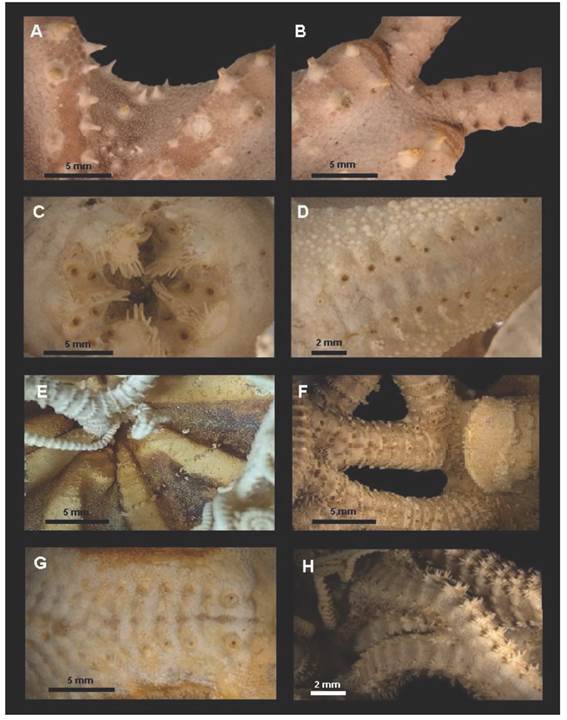
Fig. 2 Astracme mucronata (ICML-UNAM, 12308). A. detail of the interradi zone with conical spines. B. Distal region of the radial shields showing a small notch at their base and first fork of the arm. C. Mouth. D. Ventral view of the arm showing the tentacular pores. Astrocaneum herrerai (ICML-UNAM 3.118.15), E. Detail of the spines arranged in-band over radial shields. F. Radial shields showing a small notch at their base, arm with bands of spines similar to those of the disc. G. Detail of the tentacular pores at the first bifurcation. H. Arm spines after the third fork.
Astrophyton mucronatumLyman, 1869: 348. Gorgonocephalus mucronatusLyman, 1882: 265; Verrill, 1899: 85. Astrospartus mucronatusDöderlein, 1911: 73. Astracme mucronataDöderlein, 1927: 31.
Diagnosis (Manso, Gondim, & Ventura, 2014): disc covered by flattened plate-shaped dermal ossicles of varied sizes and shapes, and some granules. Large radial shields, bar-like, covered flattened by plate-shaped dermal ossicles and some granules and spines; there are irregularly distributed spine-shaped dermal ossicles on the radial shield, the interradius is covered by flattened, plate-shaped dermal ossicles and some spine-shaped ossicles (similar to the radial shields). The jaw and oral part are covered with granules larger than those on the dorsal surface.
Scanning Electron Microscopy: Astracme mucronata has spines at the radial shields, which have a flat point and a narrow base (Fig. 6C). It has three different types of hooklets; there are marked differences at the base of each type of hooklet and also in the shape of it, having one and two secondary teeth (Fig. 6F, Fig. 6G, Fig. 6H).
Genus AstrocaneumDöderlein, 1911
Diagnosis (Döderlein, 1911): disc and arms with protuberances or thicker spines. Five madreporites. The main internal and external arm branching is lightly extended, the distal ramifications are thin, thread-shaped and the lateral ramifications are cone-shaped. The spine-shaped papillae are found along the arms, are tiny, and are observable from the third or fourth bifurcation.
Astrocaneum herrerai (Clark, 1919)
Fig. 2E, Fig. 2F, Fig. 2G, Fig. 2H, Fig. 6I, Fig. 6J.
Astrocynodus herrerai A.H. Clark, 1919: 638, Fig. 96. Astrocaneum herrerai.- Döderlein, 1927: 56; Durán-González, Laguarda-Figueras, Solís-Marín, Buitrón-Sánchez, Ahearn, & Torres-Vega, 2005: 5; Pomory, 2007: 3.
Diagnosis (Clark, 1919): the oral side of the disc is covered by small granules, at the external half of the radial shields present crossed bands that are divided into sections and can be found diagonally across the shield. At the interradial oral side of the disc, it is covered with very small granules, among which there are bigger and brighter granules, grouped in a way that they form a mesh-like pattern.
Astrocaneum spinosum (Lyman, 1875)
Fig. 3A, Fig. 3B, Fig. 3C, Fig. 3D, Fig. 6K, Fig. 6L, Fig. 6M.
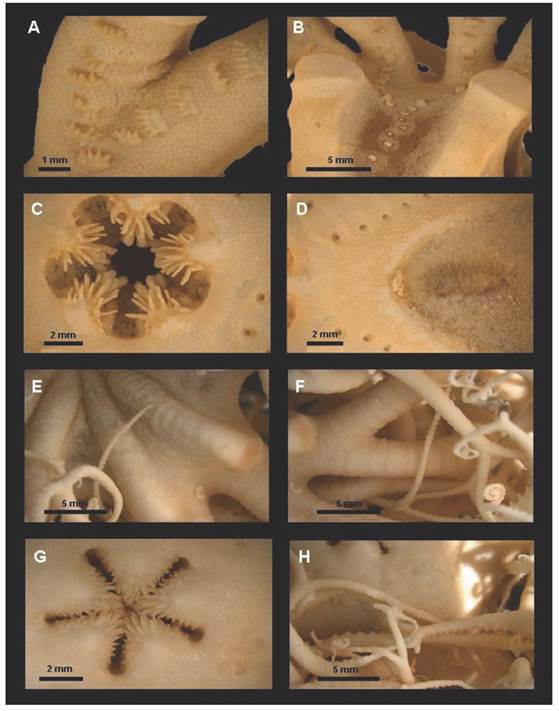
Fig. 3 Astrocaneum spinosum (ICML-UNAM 9821), A. Series of six spines on the arms. B. Dorsal view of the base of the disc and the arms. C. Mouth. D. Detail of the madreporite and tentacular pores. Astrocyclus caecilia (ICML-UNAM 3.184.1). E. Detail view of the radial shields. F. Dorsal view of the proximal portion of the arm. G. Mouth. H. Distal ramifications.
Astrophyton spinosumLyman, 1875: 29. Astrocaneum spinosum.- Döderlein, 1911: 92; Döderlein, 1927: 55; Béarez & Bujard, 2013: 2, Fig. 2- Fig. 3.
Diagnosis (Lyman, 1875): at the aboral side of the disc they have a small row of spines that are scattered in groups of two or three, at the internal angle of each of the oral interradial spaces there is a madreporite; there are no signs of arm spines close to the base of the arm, but they appear at the fifth ramification, where there are two to three arm spines per each pore; the tentacle pores are narrowly contracted.
Scanning Electron Microscopy: The genus Astrocaneum posses oblong spines, however, between A. herrerai and A. spinosum there are differences at the tip of the hooklet; A. spinosum has a flat tip and is located at the center of the hooklet (Fig. 6L). The hooklets are the main characteristic to differentiate all species, which is why between these species (A. herrerai and A. spinosum) there is a morphological difference at the base of the hooklet, been longer with a bulky protruding base in A. herrerai (Fig. 6J).
Genus AstrocyclusDöderlein, 1911
Diagnosis (Döderlein, 1911): the radial shields and arms show prominent transversal bulges and slightly ramified arms. Five madreporites at the interior edge of the oral interradius, the tentacle pores are small and appear before or immediately after the first bifurcation. Each hook of the belt posses one or two secondary teeth; the arm spines are hook-shaped, they present one to two secondary teeth.
Astrocyclus caecilia (Lütken, 1856)
Fig. 3E, Fig. 3F, Fig. 3G, Fig. 3H, Fig. 6N, Fig. 6O.
Asterophyton caeciliaLütken, 1856: 18; Lyman, 1882: 258.
Astrocyclus caecilia.- Tommasi, 1970: 13; Gondim et al., 2015: 2, Fig. 1.
Diagnosis (Tommasi, 1970): slightly elevated radial shields, without spines or tubercules, only transversal lines; at the center of the disc there are big, protruding, and elongated granules. Five madreporites, each one located in an internal angle of the interradial spaces. The arms at the oral side exhibit a small and truncated arm spine, at the tip of the arms, the arm spine transforming into hook-shaped.
Genus AstrodictyumDöderlein, 1927
Diagnosis (Döderlein, 1927): the disc and arms exhibit bulges or thick spines; the main ramification of arms is slightly extended, the distal ramifications are thin and feather-shaped. There are five madreporites, the arm spines are uniformly found along the arms, they are small and begin at a certain distance from the disc, not before the third or fourth bifurcation.
Astrodictyum cf. panamense (Verrill, 1867)
Fig. 4A, Fig. 4B, Fig. 4C, Fig. 4D, Fig. 7A, Fig. 7B, Fig. 7C.
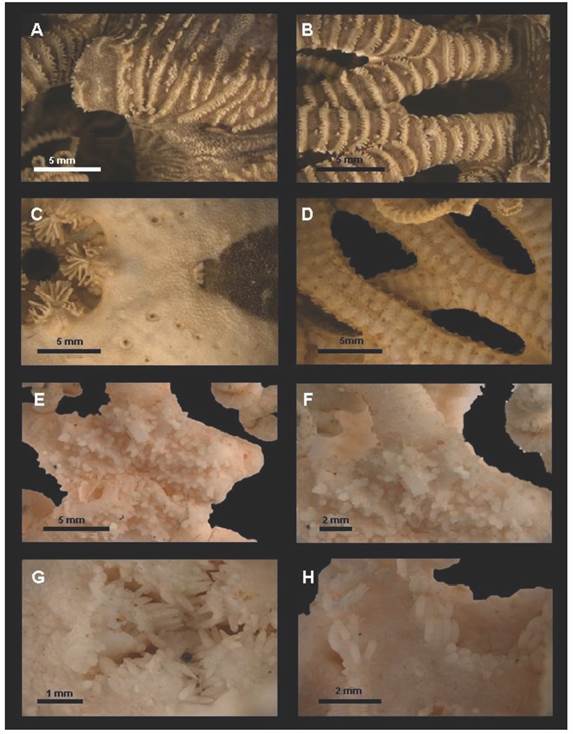
Fig. 4 Astrodictyum cf. panamense (ICML-UNAM 9822). A. Radial shield with a transverse notch. B. Dorsal view of the branching base of the arms. C. Tentacular pores. D. Ventral view of the arms. Astrogomphus vallatus (ICML-UNAM 3.165.0). E. Aboral views of the disc. F. Arm base and disk periphery. G. Mouth. H. Arm spines from basal arm segments.
Astrophyton panamenseVerrill, 1867: 251. Astrocaneum panamense.- Döderlein, 1911: 95.
Diagnosis (Verrill, 1867): the oral and aboral surfaces are covered by rough granules, at the radial shields and the dorsal side of the arms the granules are round and uniform in size, but on the ventral side they are flattened and larger. The aboral surface is slightly convex and has no presence of spines or tubercules. From two to three tentacle pores that are noted for being short, which begin at the third or fourth bifurcation; they exhibit small hooks, visible only at the terminal ramifications.
Genus AstrogomphusLyman, 1869
Diagnosis (Lyman, 1869): radial shields narrow and short, the peripheral part presents numerous spines. Simple arms, the skin is covered by a mosaic of small granules, the segments of the arms are distinguished for having ridges, each one formed by a belt of granules, some of which are very small. The arm spines have the shape of a thorny stump, arranged in groups just above the tentacle pores.
Astrogomphus vallatusLyman, 1869
Fig. 4E, Fig. 4H, Fig. 7D, Fig. 7E, Fig. 7F, Fig. 7G.
Astrogomphus vallatusLyman, 1869: 350; Durán-González et al., 2005: 59.
Diagnosis (Lyman, 1869): the entire aboral side is filled with short and thick spines, arranged in concentric rows, the radial shields have a rough and thorny appearance. Every ramification is covered by a belt of four rows of granules; the oral side of the arms is flat, they have a smooth skin that is uniformly covered by small flat granules, that look like a rugged mosaic. The interradial oral spaces are covered by small, round, and flat granules of different sizes.
Scanning Electron Microscopy: Astrogomphus vallatus presents an elongated slightly curved hooklet, with four secondary teeth, with a narrow well-defined base (Fig. 7G).
Genus AstrophytonFleming, 1828
Diagnosis (Fleming, 1828): ventral disc covered only by skin, five arms divided dicotomically. At the periphery, the genital slit is long, ranging from the peripheral end of the oral shield to the lateral edge of the disc.
Astrophyton muricatum (Lamarck, 1816)
Fig. 5A, Fig. 5B, Fig. 5C, Fig. 5D, Fig. 7H, Fig. 7I.
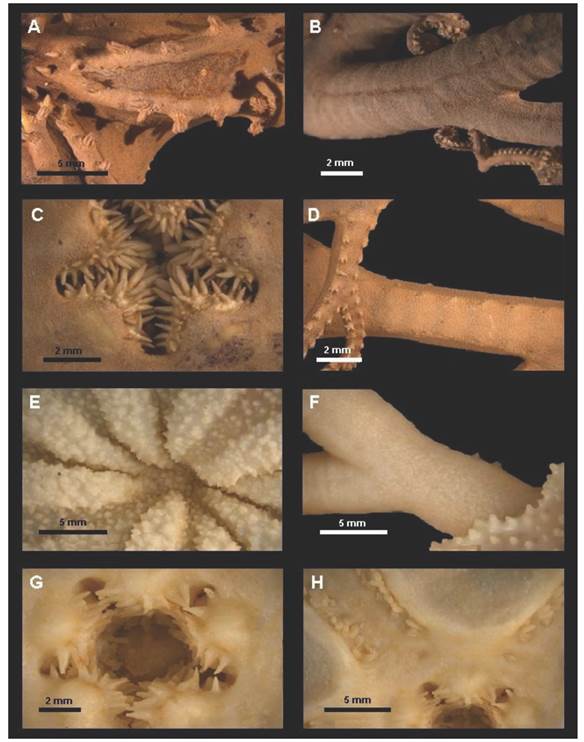
Fig. 5 Astrophyton muricatum (ICML-UNAM 3.165.0). A. detail of the radial shields. B. Dorsal view of the basal arm segments. C. Mouth. D. Dorsal and ventral view of the distal portion of the arm. Gorgonocephalus chilensis (ICML-UNAM 3.239.0). E. Partial view of the radial shields and the central region of the disc. F. Basal portion of the arm. G. Mouth. H. Arm spines that extends into the oral disc.
Euryale muricatumLamarck 1816: 538. Astrophyton arborescens, Müller & Troschel, 1842: 124. Astrophyton muricatum.- Müller & Troschel, 1842: 122; Döderlein, 1911: 7, 18, 53, 108, Fig. 1; Döderlein, 1927: 24, 25.
Diagnosis (Müller & Troschel, 1842): the radial shields stand out at the aboral side, they exhibit a thin granulation with conic spines that have a sliced tip (Fig. 5A); the arm granulation is thin and dense, covering the entire arm; the first segment of the arms do not have arm spine, only the thinner ramifications have two or three short arm spines. The oral side of the disc is characterized by having a thick arm base with few small and fine granules at the oral interradius, the arms can be exhibit either tubercules or spines.
Scanning Electron Microscopy: Astrophyton muricatum: the spines and hooklets are of two types and easily distinguished; one spine has a rectangular base and a short hooklet (Fig. 7H), meanwhile the other is curved with an ovoid base (Fig. 7I).
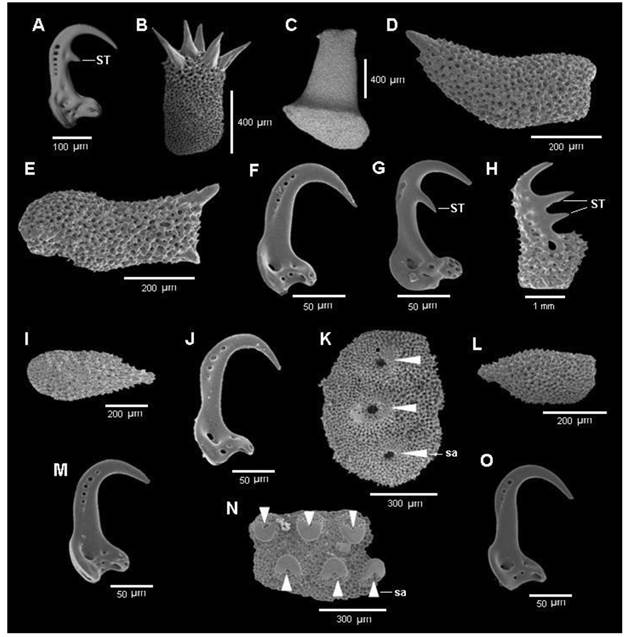
Fig. 6 SEM photographs of arm spines, hooks, and hooklet-bearing plates of different species of Gorgonocephalidae housed at ICML. Asteroporpa (Asteroporpa) annulata (ICML-UNAM 30120.1). A. Hook on distal arm. B. Arm spine of the middle portion of the arm. Astracme mucronata (ICML-UNAM 12308). C. Arm spine. D-E. Arm spine of the middle portion of the arm. F. Hook located in the middle part of an arm. G-H. Hook on the distal portion of an arm. Astrocaneum herrerai (ICML-UNAM 3.118.15). I. Arm spines. J. Simple hooks distributed along the arms. Astrocaneum spinosum (ICML-UNAM 9821). K. External structures: hooklet-bearing plate. L. Arm spine. M. Hook of the arm. Astrocyclus caecilia (ICML-UNAM 3.184.1). N. Hooklet-bearing plate. O. Hook of the arms. Abbreviations: ST. Secondary tooth. sa, Arm spine articulation.
Genus GorgonocephalusLeach, 1815
Diagnosis (Leach, 1815): it presents a convex body with five thick and dichotomic arms, the distal ramifications are thin and more bifurcated. The species have bursal slits at each side of the base of the arm’s inferior side.
Gorgonocephalus chilensis (Philippi, 1858)
Fig. 5E, Fig. 5F, Fig. 5G, Fig. 5H, Fig. 7J, Fig. 7K, Fig. 7L, Fig. 7M, Fig. 7N, Fig. 7O, Fig. 8A, Fig. 8B, Fig. 8C.
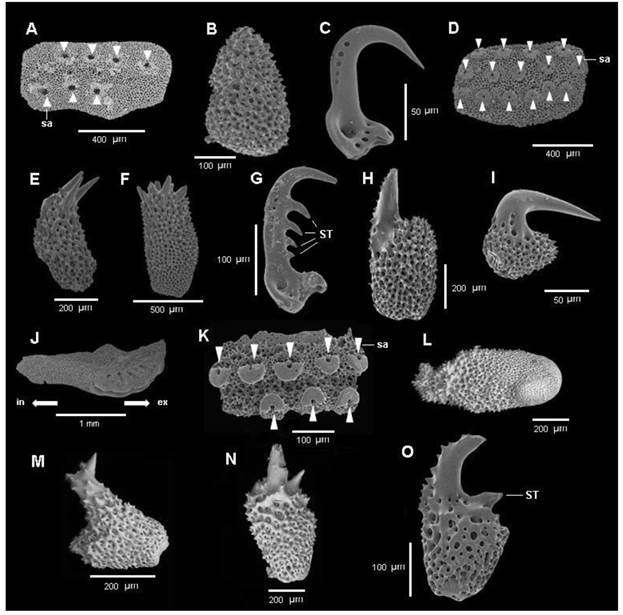
Fig. 7 SEM photographs of external structures of different species of Gorgonocephalidae housed at ICML. Astrodictyum cf. panamense (ICML-UNAM 9822). A. Hooklet-bearing plate. B. Distal dorsal plates found. C. Hook of the arm. Astrogomphus vallatus (ICML-UNAM 3.165.0). D. hooklet-bearing plate. E-F. Arm spines. G. hook of the middle portion of the arm. Astrophyton muricatum (ICML-UNAM 3.165.0). H. Arm spines. I. Hook of the arm. Gorgonocephalus chilensis (ICML-UNAM 3.239.0). J. Ventral plates. K. Hooklet-bearing plate. L-M. Arm spines. N. Arm spine. O. Arm spine from the base of the arm. Abbreviations: ST. secondary tooth. sa. spine articulation.
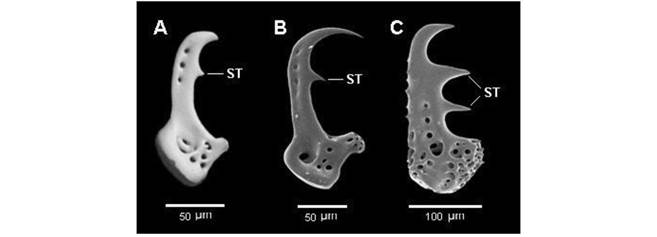
Fig. 8 SEM photographs of the hooks and the arm spine of Gorgonocephalus chilensis (ICML-UNAM 3.239.0) A. Hook from basal portion of the arm. B. Hook from the middle portion of the arm. C. arm spine from the middle portion of arm. Abbreviations: ST. Secondary tooth.
Astrophyton chilensePhilippi, 1858: 268. Astrophyton pourtalesiLyman, 1875: 28. Gorgonocephalus chilensis var. NovaezelandiaeMortensen 1924: 91. Gorgonocephalus chilensis.- Döderlein 1911: 30, 105, Fig. 5; Döderlein, 1927: 30; Monteiro & Tommasi, 1983: 56, fig. 1, fig. 2, fig. 3, fig. 4, fig. 5, fig. 6.
Diagnosis (Philippi, 1858): radial shields protruding; the arms spread five times, and the final ramifications are rosary-shaped, usually every bifurcation is divided again into another segment, but the ramifications are not identical. It has 12 main ramifications, the arms at the base get divided three more times.
Scanning Electron Microscopy: Gorgonocephalus chilensis has three types of spines and four types of hooklets, three of these hooklets have a secondary tooth, but the shape of the base of them is different (Fig. 7O, 8A, 8B), the fourth hooklet exhibits two secondary teeth and a narrow base (Fig. 8C), the perforations of the hooklets change in number and position (Fig. 8A, Fig. 8B, Fig. 8C).
Discussion
There have been published taxonomic lists which include the gorgonocephalids of the Gulf of Mexico and Gulf of California (Hernández-Herrejón, 2007; Laguarda-Figueras, Hernández-Herrejón, Solís-Marín, & Durán-González, 2009) however, they have focused only on external structures. Gorgonocephalids reported in the present study were analyzed using mainly internal taxonomic characteristics; this paper includes two genera and species for the Gulf of California and seven genera and species for the Mexican Caribbean and the Gulf of Mexico.
Asteroporpa (Asteroporpa) annulata is the type species of this genus, it was described by Örsted & Lütken (1856) in Lütken (1856), this species was collected in the western islands of the Caribbean (West Indies) (Örsted & Lütken in Lütken, 1856), however, the description based on the specimens collected from these areas was very poor. They mentioned taxonomic characters of disc highlighting the presence of irregular tubercles and rows full of hooklet-bearing plates in the arms. A. (Asteroporpa) annulata is distinguished from these species: A. (Asteroporpa) australiensis Clark, 1909, A. (A.) pulchra Clark, 1915, A. (A.) affinis Lütken, 1859, for having simple arms, a convex disc and thin arms, thin radial shields with lines of granules, presence of protruding bands surrounding the arms, oral part of the disc very granulated and hooklets present throughout the oral part of the arms.
According to Lyman (1869) and Manso, Gondim, & Ventura (2014), Astracme mucronata is defined by the following morphological characters: a thick and conspicuous disc, and radial shields with numerous spines found in the aboral interradia. Döderlein (1927) mention that A. mucronata can be distinguished from A. mediterraneus by the latter spines being present only on the radial shields. We examined eight specimens collected in Yucatan, Mexico, these specimens showed a spine (similar to the disc) on the dorsal side of the arms, present up until the third arm segment, one per segment, these specimens correspond to adult individuals.
Astrocaneum herrerai differs from A. spinosum by having a granule-covered disc, with conical spines arranged in crossed bands at the radial shields; it is also possible to observe ringed arms, each ring posses a hooklet bearing plate with a short and conical spine. Meanwhile, A. spinosum possesses a smooth skin covering the disc (except for the groups of spines located between the radial shields), and the arms possess a group of spines arranged in rows (Lyman, 1875; Clark, 1919).
According to Baker, Okanishi & Pawson (2018), Astrocyclus somaliensis differs from A. caecilian in having the disk partially covered with more or less continuous, transverse, thin white lines made up of closely packed granules, surrounding the radial shields and partially extending into the inter-shield and interradial areas; this specie was collected in the north-eastern coast of Somalia (Indian Ocean); A. caecilia has been recorded from the Caribbean Sea, Gulf of Mexico, and from northeastern Brazil by Gondim, Días & Christoffersen (2015).
All the Astrocaneum cf. panamense specimens examined in the present study, exhibited calcareous plates covered with granules and spines in crossed bands on top of their radial shields; the interradial areas have scattered packs of two to three spines; the arms are ringed and at their base, there are fragmented calcareous plates covered with spines. All the previously stated is not mentioned in the original description by Verrill (1867). It is very important to review all these specimens in the near future; it may be a new species of the genus Astrocaneum.
One of the most relevant contributions of this study is to propose the synonymization of Astrogomphus rudisVerrill, 1899 under Astrogomphus vallatusLyman, 1869. It is important to mention that this species was reported by Laguarda-Figueras et al. (2009) as Astrochele lymani. However, the material mentioned by the later authors was reviewed, and their taxonomic description does not agree with, they rather fit with the genus AstrogomphusLyman, 1869 which is represented by two species A. rudisVerrill, 1899 and A. vallatusLyman, 1869. At the moment of comparing the type material of both species we noticed that the morphological variation was minimal, Verrill (1899) differentiated the species using variations in the disk ornamentation, but both species share the same disk structures, and both species possess the same ventral ornamentation, in the oral side, close to the jaws, there are small “arm spines” distributed in group of five which also cover the entire ventral side of the arms.
This is the first study that describes Astracme mucronata, Astrocaneum herrerai, Astrocaneum spinosum, Astrogomphus vallatus and Gorgonocephalus chilensis external structures (hooks, ventral plates and spines) with providing SEM photographs. Asteroporpa (Asteromoana) muricatopatella and Asteroporpa (Asteromoana) koyoae differ from A. (Asteroporpa) annulata in that the first species has arm hooks with two lateral teeth, while the second species has three lateral teeth of the hooklets located on the basal portion of the ventral arm.
When describing A. somaliensis,Baker et al. (2018) mention the presence of three types of spines and two simple hooks of varying sizes; in the present study it was found that A. caecilia possesses only simple hooks distributed along the arm, these structures have an arched base with three well-defined pores, these hooks (A. caecilia) are smaller than the ones in A. somaliensis.
Ethical statement: authors declare that they all agree with this publication and made significant contributions; that there is no conflict of interest of any kind; and that we followed all pertinent ethical and legal procedures and requirements. All financial sources are fully and clearly stated in the acknowledgements section. A signed document has been filed in the journal archives.












 uBio
uBio 

